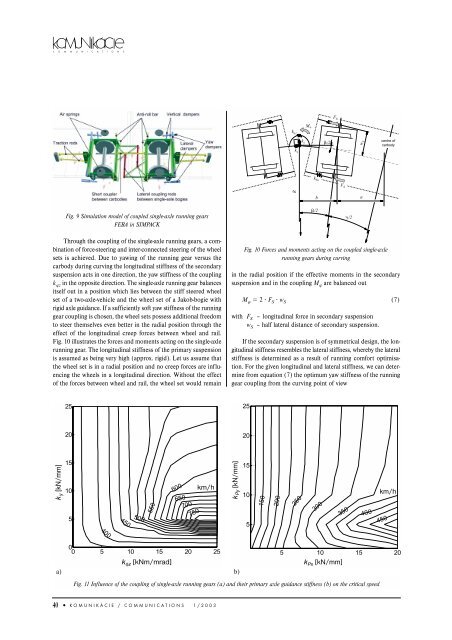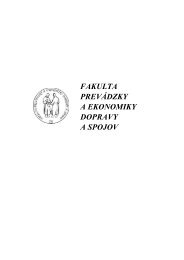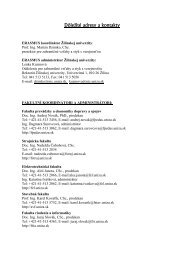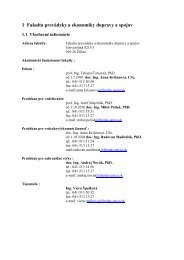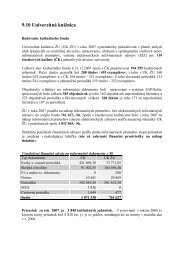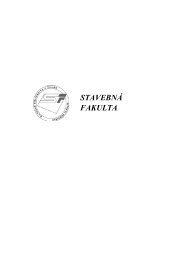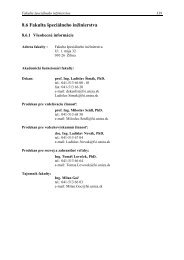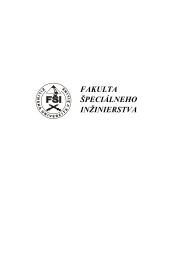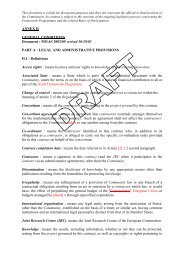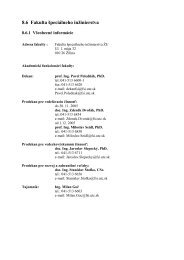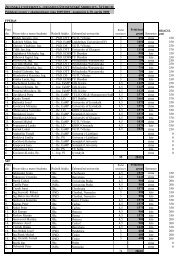posudzovanie vplyvu automobilovej dopravy na - Žilinská univerzita
posudzovanie vplyvu automobilovej dopravy na - Žilinská univerzita
posudzovanie vplyvu automobilovej dopravy na - Žilinská univerzita
You also want an ePaper? Increase the reach of your titles
YUMPU automatically turns print PDFs into web optimized ePapers that Google loves.
C O M M U N I C A T I O N S<br />
I S<br />
<br />
<br />
<br />
Fig. 9 Simulation model of coupled single-axle running gears<br />
FEBA in SIMPACK<br />
<br />
<br />
Through the coupling of the single-axle running gears, a combi<strong>na</strong>tion<br />
of force-steering and inter-connected steering of the wheel<br />
sets is achieved. Due to yawing of the running gear versus the<br />
carbody during curving the longitudi<strong>na</strong>l stiffness of the secondary<br />
suspension acts in one direction, the yaw stiffness of the coupling<br />
k z in the opposite direction. The single-axle running gear balances<br />
itself out in a position which lies between the stiff steered wheel<br />
set of a two-axle-vehicle and the wheel set of a Jakob-bogie with<br />
rigid axle guidance. If a sufficiently soft yaw stiffness of the running<br />
gear coupling is chosen, the wheel sets possess additio<strong>na</strong>l freedom<br />
to steer themselves even better in the radial position through the<br />
effect of the longitudi<strong>na</strong>l creep forces between wheel and rail.<br />
Fig. 10 illustrates the forces and moments acting on the single-axle<br />
running gear. The longitudi<strong>na</strong>l stiffness of the primary suspension<br />
is assumed as being very high (approx. rigid). Let us assume that<br />
the wheel set is in a radial position and no creep forces are influencing<br />
the wheels in a longitudi<strong>na</strong>l direction. Without the effect<br />
of the forces between wheel and rail, the wheel set would remain<br />
in the radial position if the effective moments in the secondary<br />
suspension and in the coupling M are balanced out<br />
with F S<br />
Fig. 10 Forces and moments acting on the coupled single-axle<br />
running gears during curving<br />
M 2 F S w S (7)<br />
w S<br />
– longitudi<strong>na</strong>l force in secondary suspension<br />
– half lateral distance of secondary suspension.<br />
If the secondary suspension is of symmetrical design, the longitudi<strong>na</strong>l<br />
stiffness resembles the lateral stiffness, whereby the lateral<br />
stiffness is determined as a result of running comfort optimisation.<br />
For the given longitudi<strong>na</strong>l and lateral stiffness, we can determine<br />
from equation (7) the optimum yaw stiffness of the running<br />
gear coupling from the curving point of view<br />
k y [kN/mm]<br />
km/h<br />
k Py [kN/mm]<br />
km/h<br />
k φz [kNm/mrad]<br />
k Px [kN/mm]<br />
a) b)<br />
Fig. 11 Influence of the coupling of single-axle running gears (a) and their primary axle guidance stiffness (b) on the critical speed<br />
40 ● KOMUNIKÁCIE / COMMUNICATIONS 1/2003


